FM H24-66 "Train Master" Locomotives: Specs, Roster, History
Last revised: December 27, 2024
By: Adam Burns
Of all the locomotive models produced by Fairbanks-Morse, the Train Master was by far its most revolutionary and best remembered.
Officially cataloged as the H24-66, it was a serious puller that was well built and extremely powerful for its era of production.
Unfortunately, it seems the Train Master was simply too far ahead of its time. During the 1950's most railroads had yet to embrace the high horsepower, six-axle concept.
It is one of the truly unique aspects of diesel locomotive history. Had things been different, and FM cataloged the locomotive more than a decade later, it may have been the SD40-2 of its day.
Going further, Fairbanks-Morse may have even blossomed into a major Electro-Motive rival. Today, there is one H24-66 preserved although it was built by FM's subsidiary, the Canadian Locomotive Works; Canadian Pacific #8905.
The locomotive is currently on display at the Canadian Railway Museum in Saint-Constant, Quebec.
Photos
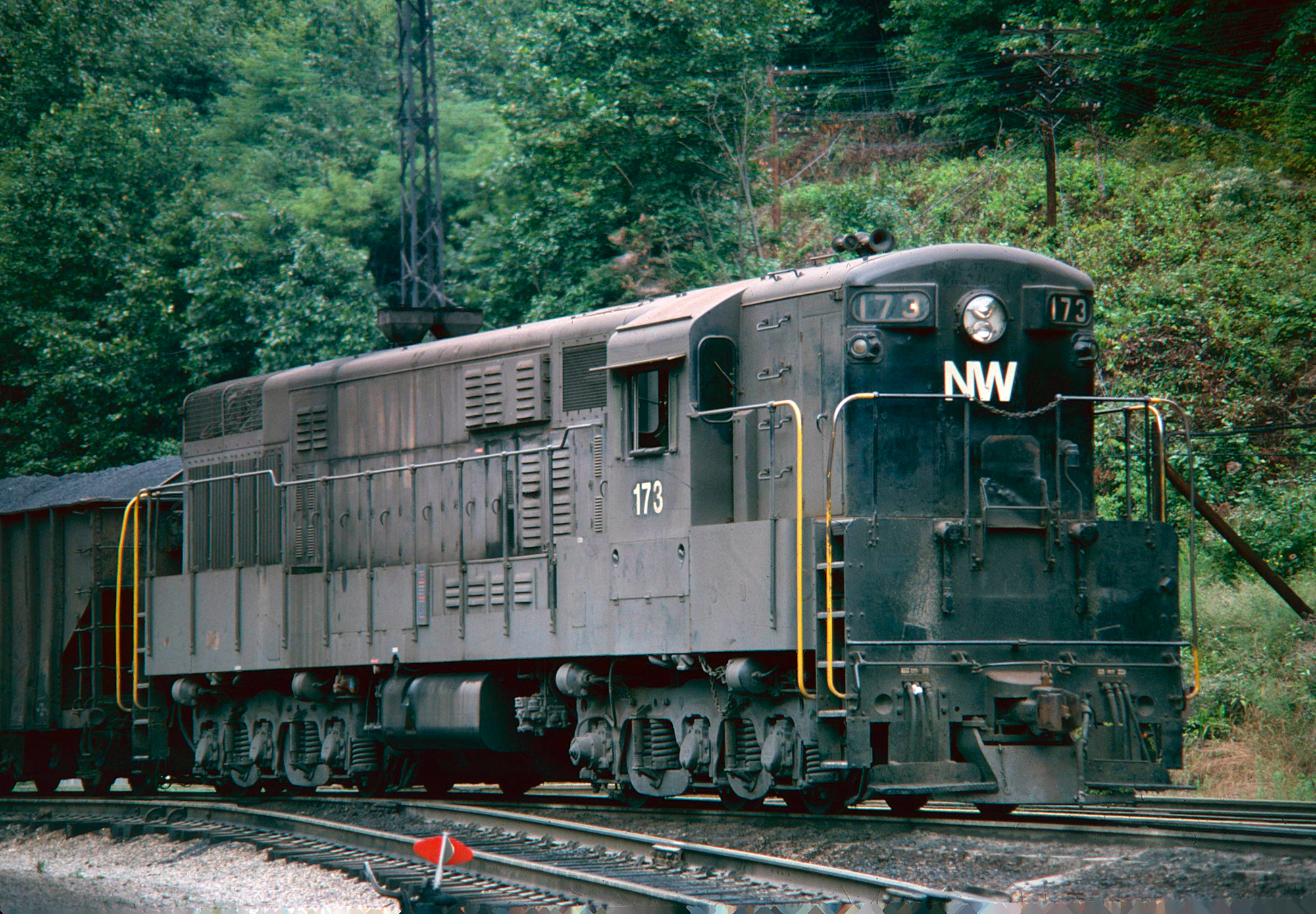 Norfolk & Western H24-66 "Train Master" #173 (ex-Virginian #73) pulls a string of loaded coal hoppers through Elmore, West Virginia over the old Virginian Railway in September, 1974. Kevin Scanlon photo. American-Rails.com collection.
Norfolk & Western H24-66 "Train Master" #173 (ex-Virginian #73) pulls a string of loaded coal hoppers through Elmore, West Virginia over the old Virginian Railway in September, 1974. Kevin Scanlon photo. American-Rails.com collection.Overview
The Train Master began production in April of 1953 and proved itself as the most "successful" locomotive on the market at the time, even if railroads didn't realize it.
The H24-66 utilized Fairbanks Morse's 2-cycle 38D8 1/8 opposed piston prime mover that could produce a hefty 2,400 horsepower and was equipped with Trimount trucks.
The TM offered the most horsepower of any locomotive in its class at that time and despite its size could also out accelerate any comparable locomotive, even making it ideal in some types of passenger service (a trait not missed by the Southern Pacific).
As John Kirkland notes in his book, "The Diesel Builders: Fairbanks-Morse And Lima Hamilton," FM actually cataloged the Train Master for passenger and freight operation by offering the option of a 2,400-gallon steam generator.
The locomotive was offered in a variety of gearing options with a maximum continuous tractive effort rating of 79,500 pounds utilizing Westinghouse electrical equipment.
When FM was forced to switch suppliers following Westinghouse's exit from the traction motor business, General Electric's model GE752 motors could offer as much as 79,500 pounds of continuous tractive effort.
Unfortunately, when the locomotive debuted railroads had yet to grasp the diesel as a high horsepower commodity.
As such, most saw the H24-66 as beyond their needs. In addition, many maintenance departments did not want to spend the effort becoming familiar with the opposed-piston prime mover.
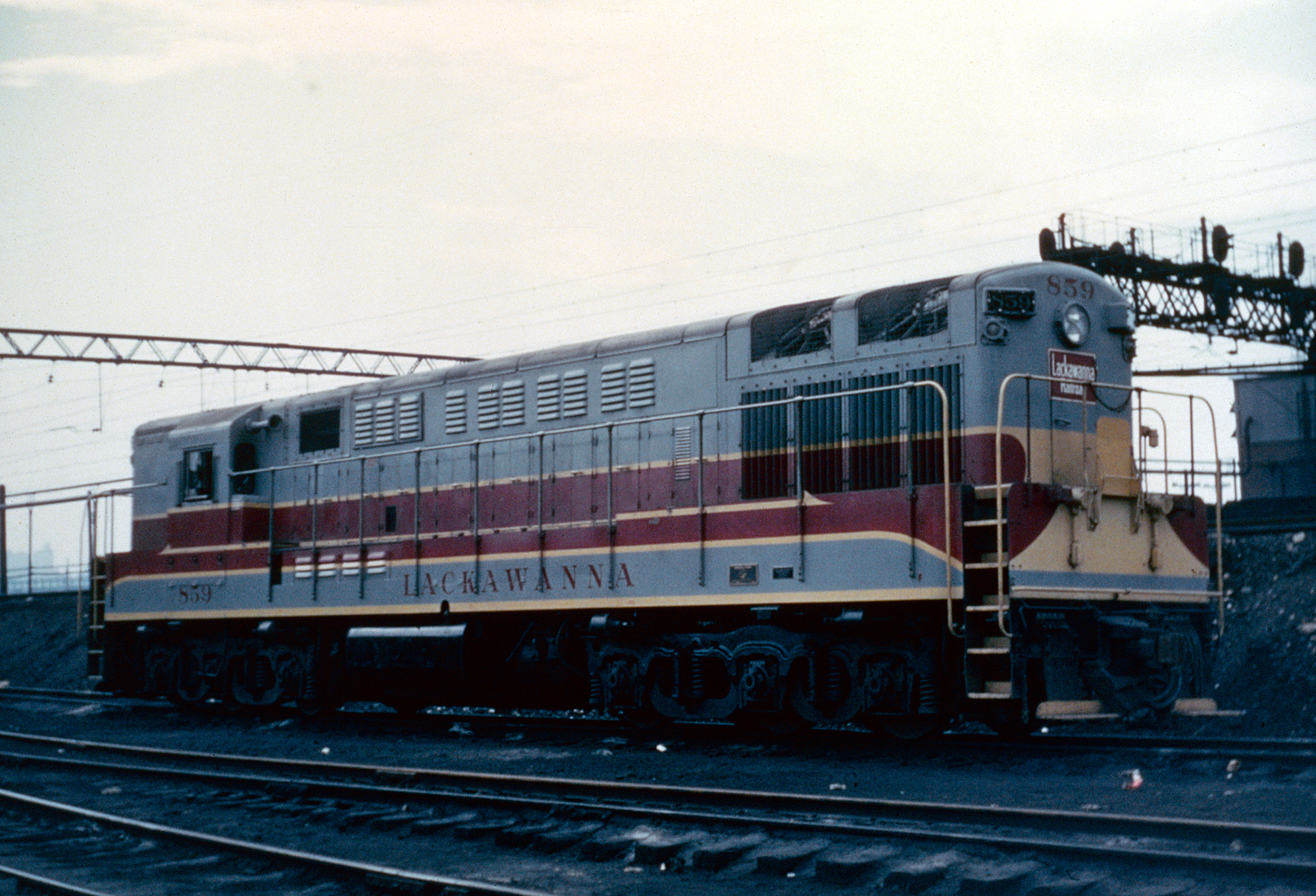 Delaware, Lackawanna & Western H24-66 "Train Master" is seen here between assignments in Hoboken, New Jersey during the 1950s. These units were often used in commuter assignments. American-Rails.com collection.
Delaware, Lackawanna & Western H24-66 "Train Master" is seen here between assignments in Hoboken, New Jersey during the 1950s. These units were often used in commuter assignments. American-Rails.com collection.Demonstrators
When production had ended in June of 1957, just 127 had been built for a handful of Class I railroads. FM also manufactured four demonstrators; TM-1 and TM-2 went to the Wabash while the Southern Pacific picked up TM-3 and TM-4.
Interestingly, TM-1 and TM-2 spent time testing on the Milwaukee Road in mid-April, 1953. Afterward, they were sent to Atlantic City, New Jersey and placed on display at the AAR Convention being held during the week of June 22nd that year.
Their mates, TM-3 and TM-4, began testing in May, 1953 and were eventually acquired by Southern Pacific in December, 1953 becoming #4800-4801.
By the time the Train Master was released, Fairbanks Morse had ended Raymond Loewy's recommendations in styling its locomotives.
However, it did continue to lean on some of his ideas giving the TM a clean look and soft, beveled edges; at 66 feet it was basically an elongated version of its smaller four axle road switchers.
Perhaps the only truly negative aspect of the Train Master was its weight; at just over 194 tons it was quite heavy and hard on the track.
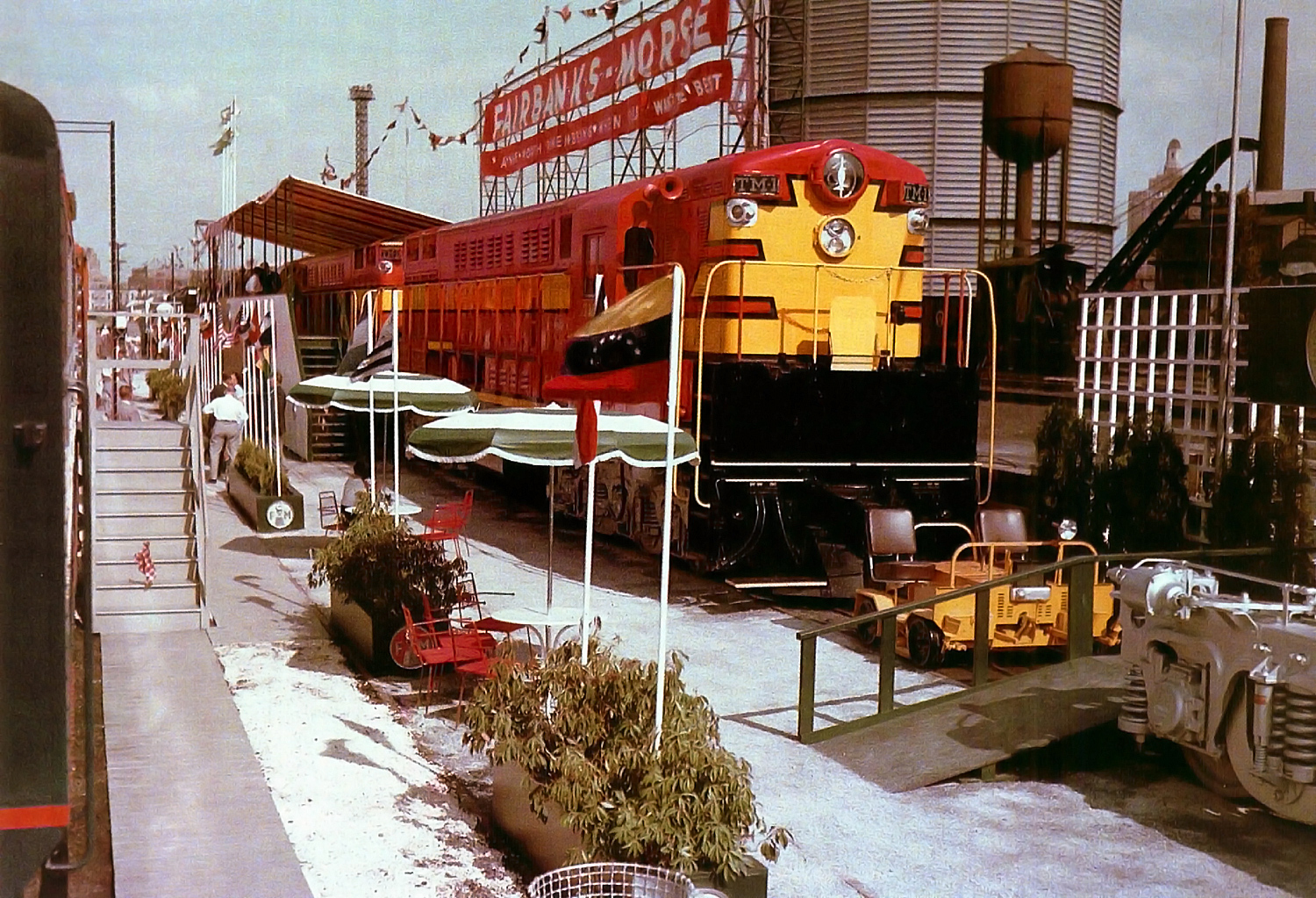 Two of Fairbanks-Morse's H24-66 "Train Master" demonstrators, TM-1 and TM-2, are showcased at the Railway Supply Manufacturers' Association trade show in Atlantic City, New Jersey in late June of 1953.
Two of Fairbanks-Morse's H24-66 "Train Master" demonstrators, TM-1 and TM-2, are showcased at the Railway Supply Manufacturers' Association trade show in Atlantic City, New Jersey in late June of 1953.Despite the Train Master's weight issues, and opposed-piston design, many railroads found that the model lived up to FM's hype.
The locomotive took a beating on lines like the Reading and Virginian where it was used in heavy coal drag service. It performed exemplary in these assignments.
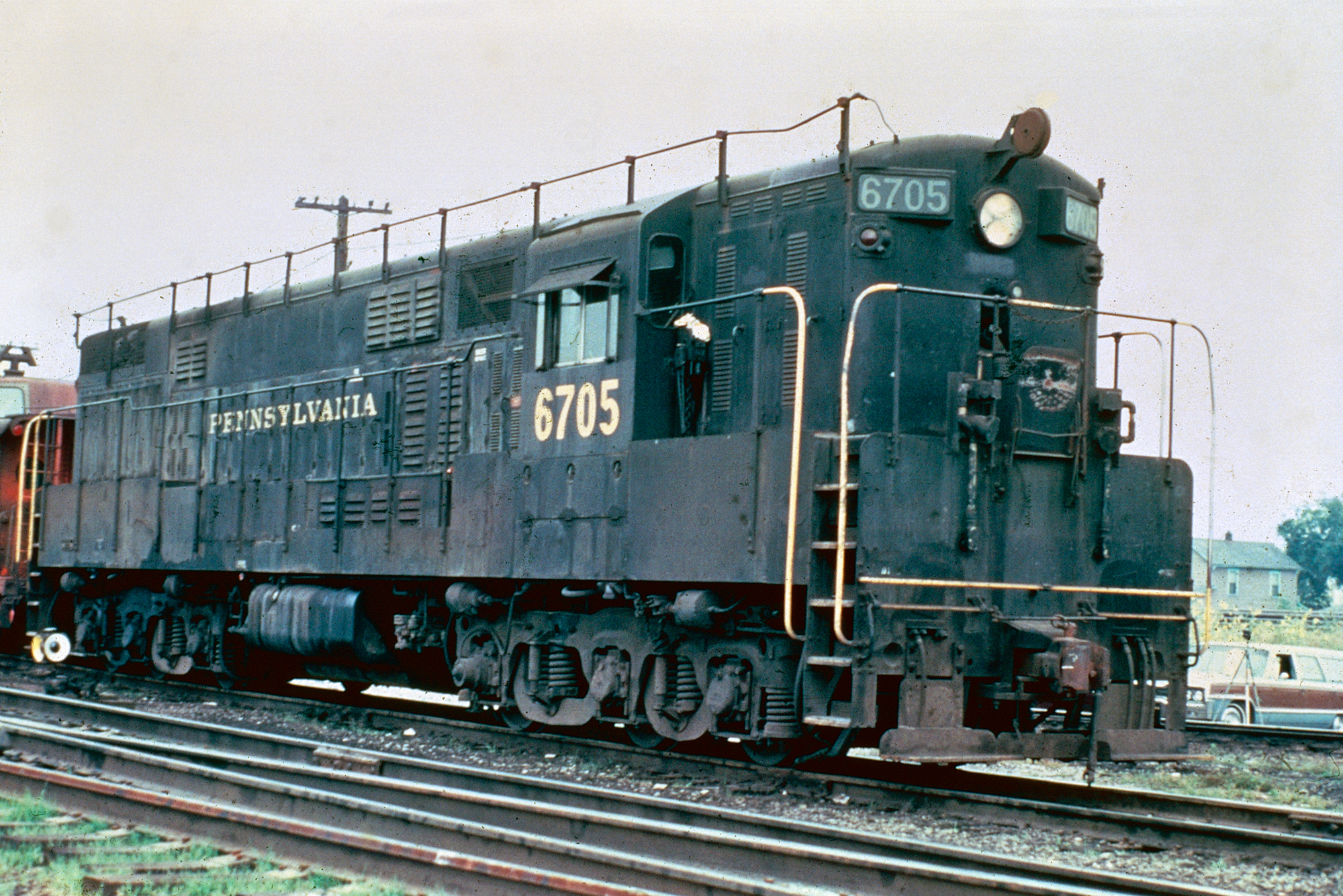 Pennsylvania "Train Master" #6705 is seen here tied down in Columbus, Ohio on September 9, 1967. American-Rails.com collection.
Pennsylvania "Train Master" #6705 is seen here tied down in Columbus, Ohio on September 9, 1967. American-Rails.com collection.In addition, Southern Pacific liked theirs so well, particularly its fast acceleration, that after newer models replaced the TMs in freight service, the railroad continued using them in commuter operations well into the 1970s.
It should be noted that while the Train Master only saw cool sales numbers it is not necessarily because Fairbanks Morse's models in general were unreliable.
Data Sheets and Specifications
Data Sheet (Westinghouse Equipment)
| Entered Production | 4/1953 (Fairbanks-Morse #TM1-TM2) |
| Years Produced | 4/1953 - 12/1955 |
| Fairbanks-Morse Class | H24-66 |
| Engine | 38D8 1/8, 12-cylinder Opposed-Piston |
| Engine Builder | Fairbanks-Morse |
| Horsepower | 2400 |
| RPM | 850 |
| Length (Inside Couplers) | 66' |
| Height (Top Of Rail To Top Of Cab) | 14' 9" |
| Width | 10' 4" |
| Weight | 375,000 Lbs |
| Trucks | C-C |
| Truck Type | Trimount |
| Truck Wheelbase | 13' |
| Wheel Size | 42" |
| Steam Generator | 4,500 Lb/Hour, 2,400 Gallon Supply (Optional) |
| Traction Motors | 370DEZ (6), Westinghouse |
| Traction Generator | 498A, Westinghouse |
| Auxiliary Generator | YG45A, Westinghouse |
| MU (Multiple-Unit) | Yes |
| Gear Ratio | See Table Below |
| Tractive Effort | See Table Below |
| Top Speed | See Table Below |
Gearing Options (Westinghouse)
| Gear Ratio | Maximum Speed | Continuous Tractive Effort (Lbs) | Continuous TE Rating Speed (MPH) |
|---|---|---|---|
| 68:15 | 65 | 78,750 | 6.2 |
| 63:15 | 70 | 72,900 | 9.9 |
| 62:17 | 80 | 63,300 | 11.4 |
Data Sheet (General Electric Equipment)
| Entered Production | 3/1954 (Virginian #50) |
| Years Produced | 3/1954 - 6/1957 |
| Fairbanks-Morse Class | H24-66 |
| Engine | 38D8 1/8, 12-cylinder Opposed-Piston |
| Engine Builder | Fairbanks-Morse |
| Horsepower | 2400 |
| RPM | 850 |
| Length (Inside Couplers) | 66' |
| Height (Top Of Rail To Top Of Cab) | 14' 9" |
| Width | 10' 4" |
| Weight | 375,000 Lbs |
| Trucks | C-C |
| Truck Type | Trimount |
| Truck Wheelbase | 13' |
| Wheel Size | 40" (42" Optional) |
| Steam Generator | 4,500 Lb/Hour, 2,400 Gallon Supply (Optional) |
| Traction Motors | GE752 (6), GE |
| Traction Generator | GT567, GE |
| Auxiliary Generator | GY43A, GE |
| MU (Multiple-Unit) | Yes |
| Gear Ratio | See Table Below |
| Tractive Effort | See Table Below |
| Top Speed | See Table Below |
Gearing Options (General Electric)
| Gear Ratio | Wheel Diameter | Maximum Speed | Continuous Tractive Effort (Lbs) | Continuous TE Rating Speed (MPH) |
|---|---|---|---|---|
| 74:18 | 40" | 66 | 79,500 | 9.3 |
| 74:18 | 42" | 69 | 75,750 | 9.8 |
| 65:18 | 40" | 75 | 69,900 | 10.6 |
| 65:18 | 42" | 79 | 66,450 | 11.2 |
Production Rosters
Fairbanks Morse
Total Built = 107
| Owner | Road Number | Construction Number | Contract Number | Completion Date | Quantity |
|---|---|---|---|---|---|
| Fairbanks-Morse (Demo) | TM1-TM2* | 24L730-24L731 | LD170 | 4/1953 | 2 |
| Fairbanks-Morse (Demo) | TM3-TM4** | 24L732-24L733 | LD165 | 5/1953 | 2 |
| Delaware, Lackawanna & Western | 850-859 | 24L734-24L743 | LD165 | 6/1953 | 10 |
| Reading Railroad | 800-801 | 24L779-24L780 | LD155 | 9/1953 | 10 |
| Reading Railroad | 860-861 | 24L781-24L782 | LD155 | 10/1953 | 2 |
| Southern Pacific | 4810-4813 | 24L787-24L790 | LD164B | 11/1953 | 4 |
| Southern Pacific | 4802-4805 | 24L91-24L794 | LD164A | 12/1953 | 4 |
| Reading Railroad | 802-806 | 24L795-24L799 | LD158 | 11/1953 | 5 |
| Southern Pacific | 4814-4815 | 24L800-24L801 | LD164B | 2/1954 | 2 |
| Southern Pacific | 4806-4809 | 24L803-24L806 | LD164A | 12/1953 | 4 |
| Virginian Railway | 50-57 | 24L807-24L814 | LD167-1 | 3/1954 | 8 |
| Virginian Railway | 58-64 | 24L838-24L844 | LD167-1 | 4/1954 | 7 |
| Virginian Railway | 65-68 | 24L845-24L848 | LD167-1 | 5/1954 | 4 |
| Central Railroad Of New Jersey | 2401-2404 | 24L849-24L852 | LD171 | 5/1954 | 4 |
| Central Railroad Of New Jersey | 2405-2407 | 24L853-24L855 | LD171 | 6/1954 | 3 |
| Southern Railway (CNO&TP) | 6300-6301 | 24L856-24L857 | LD179 | 5/1955 | 2 |
| Southern Railway (CNO&TP) | 6302-6304 | 24L858-24L860 | LD179 | 6/1955 | 3 |
| Canadian Pacific | 8900 | 24L861 | C635 | 6/1955 | 1 |
| Canadian National | 3000 | 24L862 | C636 | 6/1955 | 1 |
| Reading Railroad | 866, 867, 862 | 24L863-24L865 | LD185 | 11/1955 | 3 |
| Reading Railroad | 863-864 | 24L882-24L883 | LD185 | 11/1955 | 2 |
| Reading Railroad | 865 | 24L884 | LD185 | 12/1955 | 1 |
| Central Railroad Of New Jersey | 2408-2410 | 24L885-24L887 | LD191 | 3/1956 | 3 |
| Central Railroad Of New Jersey | 2411-2413 | 24L888-24L890 | LD191 | 4/1956 | 3 |
| Wabash | 552-552A | 24L891-24L892 | LD194 | 4/1956 | 2 |
| Wabash | 553-553A | 24L893-24L894 | LD194 | 5/1956 | 2 |
| Wabash | 554-554A | 24L895-24L896 | LD194 | 5/1956 | 2 |
| Pennsylvania | 8699-8703 | 24L897-24L901 | LD200 | 8/1956 | 5 |
| Pennsylvania | 8704-8707 | 24L902-24L905 | LD200 | 9/1956 | 4 |
| Reading Railroad | 807-808 | 24L906-24L907 | LD204 | 12/1956 | 2 |
| Delaware, Lackawanna & Western | 860-861 | 24L1035-24L1036 | LD203 | 11/1956 | 2 |
| Virginian Railway | 69-70 | 24L1037-24L1038 | LD210 | 5/1957 | 2 |
| Virginian Railway | 71 | 24L1039 | LD210 | 6/1957 | 1 |
| Virginian Railway | 72 | 24L1040 | LD210 | 5/1957 | 1 |
| Virginian Railway | 73-74 | 24L1041, 20L1048 | LD210 | 6/1957 | 2 |
* Became Wabash Railroad #550-551 in February, 1954.
** Became Southern Pacific #4800-4801 in December, 1953.
Canadian Locomotive Company
Total Built = 20
| Owner | Road Number | Construction Number | Completion Date | Quantity |
|---|---|---|---|---|
| Canadian Pacific | 8905-8906 | 2922-2923 | 6/1956 | 2 |
| Canadian Pacific | 8907-8908 | 2924-2925 | 7/1956 | 2 |
| Canadian Pacific | 8909-8910 | 2926-2927 | 8/1956 | 2 |
| Canadian Pacific | 8901-8904 | 2928-2931 | 8/1956 | 4 |
| Canadian Pacific | 8911-8915 | 2932-2936 | 9/1956 | 5 |
| Canadian Pacific | 8916-8920 | 2937-2941 | 10/1956 | 5 |
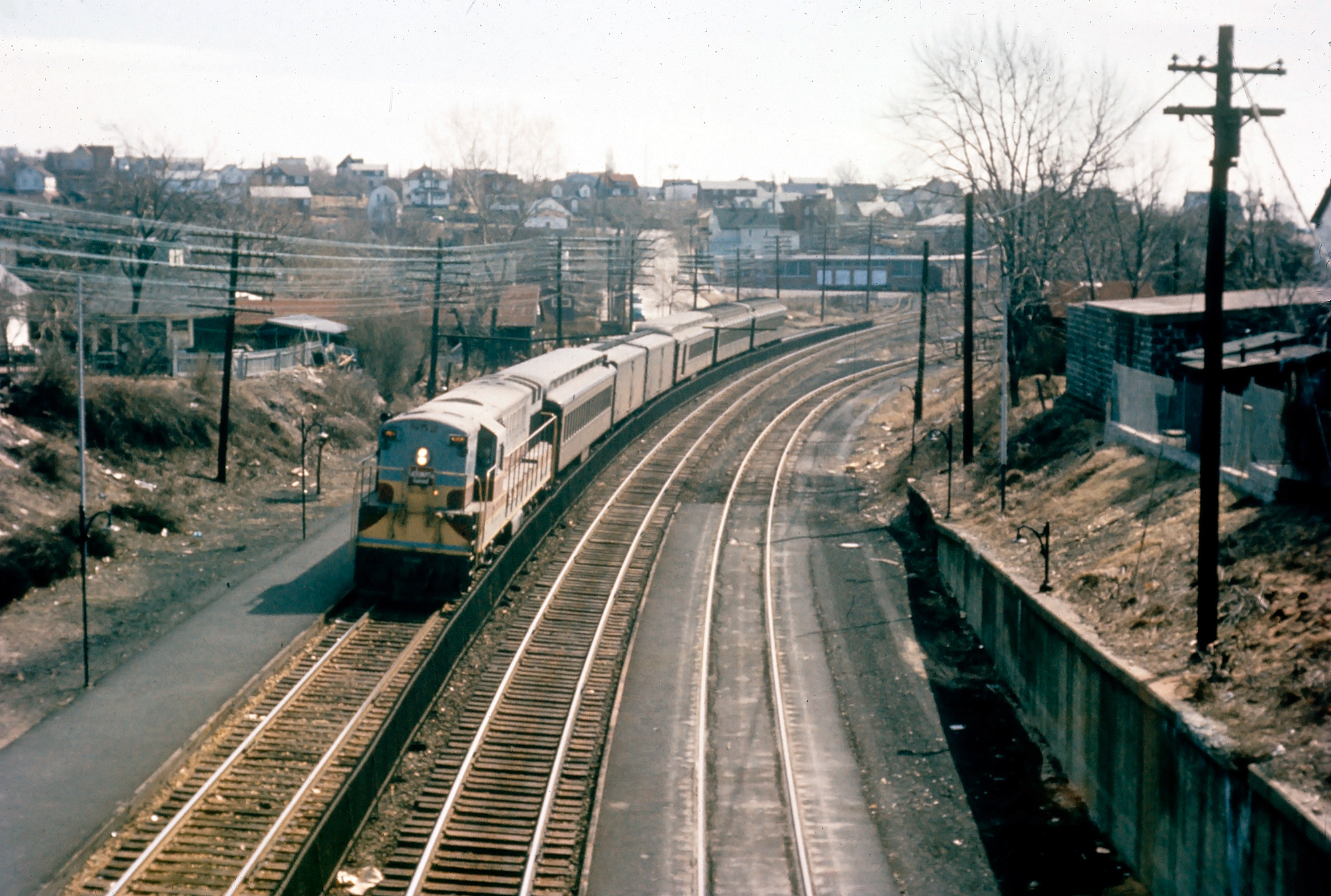 Lackawanna "Train Master" #852 makes a stop at Kingsland Station in Lyndhurst, New Jersey with a westbound local out of Hoboken, circa 1957. Meyer Pearlman photo. American-Rails.com collection.
Lackawanna "Train Master" #852 makes a stop at Kingsland Station in Lyndhurst, New Jersey with a westbound local out of Hoboken, circa 1957. Meyer Pearlman photo. American-Rails.com collection.Reliability with FM's diesel locomotives has often been questioned but the primary issue seems primarily due to the complexity of the opposed-piston prime mover to maintain; it was far different from the standard designs offered by the other builders.
For instance, it has been noted by John Kirkland book The Diesel Builders Volume 1 that the Train Master performed admirably for more than 20 years on the Southern Pacific due to a maintenance team that understood the model and its mechanical inner workings, despite taking a daily beating in freight service.
Recent Articles
-
Montana Dinner Train Rides Near Lewistown!
Jan 08, 26 03:03 PM
The Charlie Russell Chew Choo turns an ordinary rail trip into an evening event: scenery, storytelling, live entertainment, and a hearty dinner served as the train rumbles across trestles and into a t… -
Alabama's - Murder Mystery - Dinner Train Rides
Jan 08, 26 02:19 PM
There is currently one location in the state offering a murder mystery dinner experience, the Wales West Light Railway! -
Rhode Island's - Murder Mystery - Dinner Train Rides
Jan 08, 26 01:43 PM
Let's dive into the enigmatic world of murder mystery dinner train rides in Rhode Island, where each journey promises excitement, laughter, and a challenge for your inner detective. -
Florida's - Wine Tasting - Train Rides
Jan 08, 26 01:13 PM
Wine by train not only showcases the beauty of Florida's lesser-known regions but also celebrate the growing importance of local wineries and vineyards. -
Texas's - Wine Tasting - Train Rides
Jan 08, 26 12:30 PM
This article invites you on a metaphorical journey through some of these unique wine tasting train experiences in Texas. -
New York's - Wine Tasting - Train Rides
Jan 08, 26 11:32 AM
This article will delve into the history, offerings, and appeal of wine tasting trains in New York, guiding you through a unique experience that combines the romance of the rails with the sophisticati… -
California Dinner Train Rides In Sacramento!
Jan 08, 26 11:21 AM
Just minutes from downtown Sacramento, the River Fox Train has carved out a niche that’s equal parts scenic railroad, social outing, and “pick-your-own-adventure” evening on the rails. -
New Jersey Dinner Train Rides In Woodstown!
Jan 08, 26 10:31 AM
For visitors who love experiences (not just attractions), Woodstown Central’s dinner-and-dining style trains have become a signature offering—especially for couples’ nights out, small friend groups, a… -
Nevada's - Murder Mystery - Dinner Train Rides
Jan 07, 26 02:12 PM
Seamlessly blending the romance of train travel with the allure of a theatrical whodunit, these excursions promise suspense, delight, and an unforgettable journey through Nevada’s heart. -
West Virginia's - Murder Mystery - Dinner Train Rides
Jan 07, 26 02:08 PM
For those looking to combine the allure of a train ride with an engaging whodunit, the murder mystery dinner trains offer a uniquely thrilling experience. -
Kansas's - Murder Mystery - Dinner Train Rides
Jan 07, 26 01:53 PM
Kansas, known for its sprawling wheat fields and rich history, hides a unique gem that promises both intrigue and culinary delight—murder mystery dinner trains. -
Michigan's - Wine Tasting - Train Rides
Jan 07, 26 12:36 PM
In this article, we’ll delve into the world of Michigan’s wine tasting train experiences that cater to both wine connoisseurs and railway aficionados. -
Indiana's - Wine Tasting - Train Rides
Jan 07, 26 12:33 PM
In this article, we'll delve into the experience of wine tasting trains in Indiana, exploring their routes, services, and the rising popularity of this unique adventure. -
South Dakota's - Wine Tasting - Train Rides
Jan 07, 26 12:30 PM
For wine enthusiasts and adventurers alike, South Dakota introduces a novel way to experience its local viticulture: wine tasting aboard the Black Hills Central Railroad. -
Kentucky Thomas The Train Rides
Jan 07, 26 12:26 PM
If you’ve got a Thomas fan in the house, Day Out With Thomas at the Kentucky Railway Museum is one of those “circle it on the calendar” weekends. -
Michigan's Thomas The Train Rides
Jan 07, 26 12:10 PM
If you’ve got a Thomas fan in the house, few spring outings feel as “storybook-real” as Day Out With Thomas™ at Greenfield Village in Dearborn, Michigan. -
Texas Dinner Train Rides On The TSR!
Jan 07, 26 11:36 AM
Today, TSR markets itself as a round-trip, four-hour, 25-mile journey between Palestine and Rusk—an easy day trip (or date-night centerpiece) with just the right amount of history baked in. -
Iowa Dinner Train Rides In Boone!
Jan 07, 26 11:06 AM
If you’ve ever wished you could pair a leisurely rail journey with a proper sit-down meal—white tablecloths, big windows, and countryside rolling by—the Boone & Scenic Valley Railroad & Museum in Boon… -
Wisconsin Dinner Train Rides In North Freedom!
Jan 06, 26 10:18 PM
Featured here is a practical guide to Mid-Continent’s dining train concept—what the experience is like, the kinds of menus the museum has offered, and what to expect when you book. -
Pennsylvania Dinner Train Rides In Boyertown!
Jan 06, 26 06:48 PM
With beautifully restored vintage equipment, carefully curated menus, and theatrical storytelling woven into each trip, the Colebrookdale Railroad offers far more than a simple meal on rails.
Sources
- Kirkland, John F. Diesel Builders, The: Volume One, Fairbanks-Morse And Lima-Hamilton. Glendale: Interurban Press, 1985
- Marre, Louis A. Diesel Locomotives: The First 50 Years, A Guide To Diesels Built Before 1972. Milwaukee: Kalmbach Publishing Company, 1995
- Pinkepank, Jerry A. Diesel Spotter's Guide. Milwaukee: Kalmbach Publishing Company, 1967.
- Schafer, Mike. Vintage Diesel Locomotives. Osceola: MBI Publishing, 1998.
- Solomon, Brian. American Diesel Locomotive, The. Osceola: MBI Publishing, 2000.

















